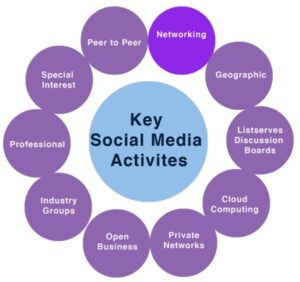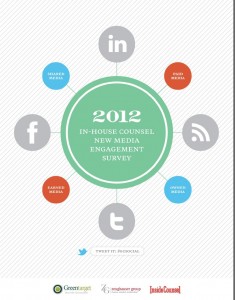I’m excited to share with readers of the Virtual Marketing Officer blog a short excerpt about creating an effective profile on LinkedIn taken from one chapter of my new book, social.lawyers: Transforming Business Development, (by Jayne Navarre), which was published by Thomson West last month. (The book is now available for purchase on their website here.) Although the excerpt addresses a simple, yet practical approach to creating a profile, the book is not just a how-to tome on social web tools. It covers philosophical and strategic components, including a full chapter on social media and networking for the organization, as well as law firm policy and ethical best practices for participants.
About social.lawyers: Transforming Business Development
The book takes a fairly in depth look at what I believe are the most oft asked questions and oft encountered challenges in marketing a professional services practice, both online and offline. In fact, one of my primary objectives in writing the book was to debunk the hype surrounding social media and online networking and to cast light on the fact that….We’re not doing anything different in marketing professional practices, we’re just doing it differently!
Yes, there are a few attitude shifts needed to leverage these powerful new tools—the book addresses those early on. And, yes, the fact that content travels further and faster is something to get used to managing. But, overall, the fundamentals of business development, marketing, public relations, publicity, and communications with stakeholders has not changed:
- exposure is critical to getting found,
- relationships matter,
- corporate messages need human connection, and
- people purchase services from those they trust.
I hope you will read and comment on this excerpt and buy the book! If you are a blogger and would like to review the book, please drop me a note and a link to your blog. If it looks like a fit, I’ll send you a review copy. Meanwhile, here’s just a small snippet of one of the more practical sections of the book.
CHAPTER 5: PROFILE AND PERSONA
Quick, what was on the last billboard you passed? Do you remember what it said? —“You’re faster than you think” (Nike), was it “Pick your style” (Levis) or “100% UrbanProof” (Nissan)? Do you remember the visual story? –Athlete in running shoes hurdling an oversized obstacle –a giant pair of blue jeans with a wired in joystick hanging from the back pocket –sleek silver automobile in a chic urban setting? When it comes to crafting your online profile for business networking, there are two things we can learn from the best outdoor signage—you need only a few important words in large print so it can be easily seen as people pass by at high speeds, and you need only one large brilliant image that quickly tells the story to keep people thinking about it miles down the road—to make it memorable.
Billboards are designed for high-density consumer exposure and so should your profile. Billboards must make a strong first impression, as many passersby are often seeing it for the first time. The same is true for your profile. A first impression may be the last impression you leave with someone if you do not take the time to give passersby something of what they need to know about you right up front.
Profile
Profiles on social networking sites conform to a fairly standard set including your name, title, geographic location, employment, education, summary of experience, Website addresses, interests, groups and associations. After that they vary according to the purpose of the community. For example, you may be able to add recommendations, third-party applications, PowerPoint presentations, articles, an in-site blog, or other community specific activities. However, community profiles are so similar in design that in order to save time, it is smart to draft one complete social-networking profile and store it in a document. Each time you join a new community you can quickly access the basics without starting over.
Your title is the first and probably the most important piece of your profile—those “few important words in very large print” that can be read and understood quickly by people passing by. For example, on LinkedIn your name and title are the only part of your profile that follows you throughout the community as you post to discussion forums, join groups, and answer Q&A. Additionally, a good title will contain specific keywords that improve your ranking in on-site keyword searches within most social networks.
In a networking situation, online of offline, the first question that someone you have not previously met will ask you is “what do you do?” (More accurately they are asking, “What do you do for others that you might be able to do for me?” That’s the real question you need to answer.) Think of your title as an elevator speech—that short sentence you use when introducing yourself to others in a business setting.
When someone asks you “and what do you do?” and you respond, “I’m a lawyer,” you’re probably getting a blank stare and dead silence—often a real conversation killer. The fact is, their reaction is not because you are a lawyer; it is because you are representing yourself one-dimensionally. People will typically project their preconceived notions onto a single word—like lawyer—when there is nothing to put it into a context. Some people hear the word lawyer and think Jack McCoy (Law and Order), while others think “ambulance chaser” and still others think “that smart woman who helped my mother manage her estate.” The best way to avoid being stereotyped is to give your answer context. In your title, reveal something distinctly memorable about what you do that others might be interested in knowing about you—you are multi-dimensional, right?
There’s little or nothing in the words “attorney,” “lawyer,” “shareholder,” or “managing partner” that reveals what you do for your clients or what you could do for the person with whom you are speaking—or for that matter, little that inspires further conversation. Your title should reveal more than simply your job title, i.e. “Jonathan Jones, Partner, Jones Law Firm” or “Jonathan Jones, Founding Attorney.” At the very least you should tell passersby what kind of attorney you are or that the focus of your practice is business law, i.e., “Jonathan Jones, Global Business Attorney at Jones Law Firm, N.Y.C.” Better yet, you could add your practice area, plus a specific industry niche, i.e. “Jonathan Jones, Legal Counsel to Global Internet-Based Technology Companies, Mergers and Acquisitions, Complex Finance Structuring.” You have the rest of your profile to tell readers the name of your firm, where you are located, your role in the law firm and, of course, all the other things they’ll want to know once they have an initial idea about why they might want to connect to you.
Everyone is busy, social networking online can be noisy and the time you have to devote to business development on the social Web is finite. Make it easy for the right people to cut through the noise and reach out to talk to you. A good title can help them, in an instant, identify your interests and quickly assess what you do that you might do for them or someone they know. A thoughtfully constructed title, one that describes what you do for others, will decrease your missed opportunities—where preconceived stereotypes got in the way—and reduce wasted time in fielding invitations from people who will never earn you a penny of new business.
Bottom line: Your title on a social networking site is your billboard. It is the first impression that people get from you, about you, as they’re speeding down the Internet super highway.
Here’s a summary of contents:
Summary of Contents
PART 1. THE APPROACH
Chapter 1. Change
Chapter 2. Fundamentals Do Not Change
Chapter 3. How Things Work
PART II. STRATEGY
Chapter 4. Build a Better Mousetrap
Chapter 5. Profle and Persona
Chapter 6. Policy and Privacy
Chapter 7. Posting
PART III. IMPLEMENTING A STRATEGY
Chapter 8. Blogs and Twitter
Chapter 9. The Role of the Organization
Chapter 10. Social Lawyers’ Case Studies
Index
Cheers!





Congrats Jayne! This excerpt is really good – engaging, thoughtful and most importantly, includes very useful advice. Knowing you, I’m sure the rest of the book is just as great.
Thanks Aviva! I’m really excited about the book. As you know, social media and networking is a moving target. I took special care to write the book within the context of established, classic business development and marketing principles. Although I’ll be releasing updated editions annually to address new tools, this one is not to be missed as it sets forth timeless fundamentals upon which to build.
The excerpt is excellent. Most social media experts will tell a client to complete their profile since that is the only part of LinkedIn that is searchable, but the advice to make your title tell a story of what you do is brilliant.
Thanks for the comment, Rosalie. An eminent domain lawyer I work with told me that this one change to his profile, making his title more descriptive, made all the difference in his name turning up in search results on LinkedIn and has opened some opportunities to connect with others he would not have otherwise met.